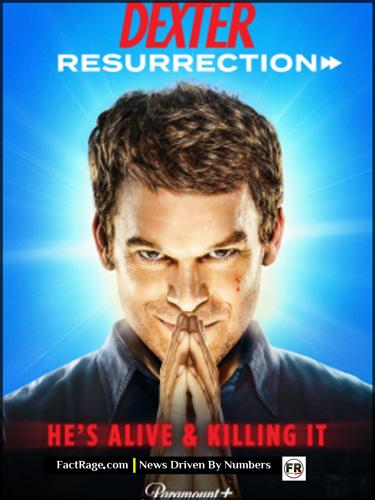HOLLYWOOD – Showtime has announced “Dexter: Resurrection,” a new series that will once again revive its iconic serial killer, marking the latest example of a major industry trend where old television shows are brought back from the dead.
- A Second Revival – Showtime is developing “Dexter: Resurrection,” the second revival of the series since its original 2013 finale, following the 2021 limited series “Dexter: New Blood.”
- Driven By Data – “Dexter: New Blood” was a massive success, becoming Showtime’s most-watched series in its history and demonstrating a clear, data-backed financial incentive for continuing the franchise.
- An Industry-Wide Strategy – The move reflects a broader Hollywood strategy of leveraging proven Intellectual Property (IP) to compete in the crowded streaming market, where familiar titles are seen as a safer investment.
The return of Dexter Morgan raises a question that extends far beyond this single character: in an era of seemingly infinite content, why can’t television quit its past? The answer lies in a complex mix of financial strategy, audience demand, and the high-stakes battle for your subscription.
Hollywood’s Nostalgia Playbook
![]() When a character like Dexter Morgan returns, it’s easy to focus on fan service or nostalgia. But the real story here isn’t just about reviving a killer—it’s about the entertainment industry’s calculated reliance on its own past. This trend reveals a major shift in Hollywood’s creative economy, where proven franchises are now the safest bets in the high-stakes streaming wars. It’s a business decision dressed up as a creative one, and it’s redefining what gets made.
When a character like Dexter Morgan returns, it’s easy to focus on fan service or nostalgia. But the real story here isn’t just about reviving a killer—it’s about the entertainment industry’s calculated reliance on its own past. This trend reveals a major shift in Hollywood’s creative economy, where proven franchises are now the safest bets in the high-stakes streaming wars. It’s a business decision dressed up as a creative one, and it’s redefining what gets made.
Read On…
Here, we’ll connect the dots between the streaming wars, the value of old IP, and why your favorite shows from the past are suddenly Hollywood’s biggest priority for the future.
What’s Driving Dexter’s Return to TV?

The confirmation of “Dexter: Resurrection” by Paramount Global-owned Showtime isn’t a surprise to industry watchers. It’s a direct response to the immense success of its predecessor, “Dexter: New Blood.” That 2021-2022 revival was a ratings powerhouse, averaging nearly 8 million viewers a week across all platforms and shattering Showtime’s viewership records.
For a media company, those numbers are not just a success story; they are a business case. In an environment where launching a new series is a costly and high-risk gamble, reviving a property with a built-in, loyal fanbase is a calculated financial decision. The marketing is simpler, the audience is primed, and the potential for a return on investment is significantly higher. The success of “New Blood” provided a clear proof-of-concept that audiences were still invested in the character, even years after a widely criticized original series finale.
How Revivals Became a Weapon in the Streaming Wars
The “Dexter” revival is a symptom of a much larger condition in the entertainment landscape. The so-called “streaming wars” have fundamentally changed how content is valued. Services like Netflix, Max, Disney+, and Paramount+ are no longer just building libraries; they are curating arsenals of Intellectual Property (IP). Familiar titles act as powerful lures to attract new subscribers and, just as importantly, reduce “churn”—the rate at which customers cancel their subscriptions.
A show like “Dexter” serves a dual purpose. Its revival generates headlines and brings in legacy fans, while also driving new and existing subscribers to watch or re-watch the original nine seasons available on the platform. We’ve seen this strategy deployed across the industry, with series like “Frasier” (Paramount+), “And Just Like That…” (Max), and “Night Court” (Peacock) all being resurrected to bolster their respective streaming services. These revivals are not just creative endeavors; they are strategic assets in a multi-billion dollar corporate battle.
Is This Good for Storytelling or Just for Business?
The central tension in this trend is the balance between commerce and art. For fans, a revival offers the chance to revisit beloved characters and, in some cases, see a dissatisfying ending get a do-over. The original “Dexter” finale in 2013 was one of the most polarizing in modern TV history, a fact that undoubtedly fueled interest in “New Blood’s” attempt to provide a more definitive conclusion.
However, critics of the trend argue that this reliance on nostalgia stifles originality and can lead to diminishing creative returns. For every successful revival, there are others that fail to capture the magic of the original, potentially tarnishing its legacy. The challenge for creators of “Dexter: Resurrection” will be to justify its existence from a storytelling perspective, offering a compelling new chapter that feels necessary, rather than simply being a financially motivated encore. Whether it succeeds will determine if this resurrection is a creative triumph or simply another ghost from television’s past.
The Nostalgia Engine
![]() The return of Dexter isn’t just a creative encore; it’s a look at the modern Hollywood playbook where proven IP has become the safest bet in a high-risk game. In an era defined by the streaming wars, nostalgia is no longer just a feeling—it’s a core business strategy, a reliable engine fueled by established fanbases. As streamers continue to mine the past for future hits, the line between a welcome reunion and a creatively bankrupt echo grows ever thinner, leaving audiences to decide which revivals are truly worth resurrecting.
The return of Dexter isn’t just a creative encore; it’s a look at the modern Hollywood playbook where proven IP has become the safest bet in a high-risk game. In an era defined by the streaming wars, nostalgia is no longer just a feeling—it’s a core business strategy, a reliable engine fueled by established fanbases. As streamers continue to mine the past for future hits, the line between a welcome reunion and a creatively bankrupt echo grows ever thinner, leaving audiences to decide which revivals are truly worth resurrecting.














